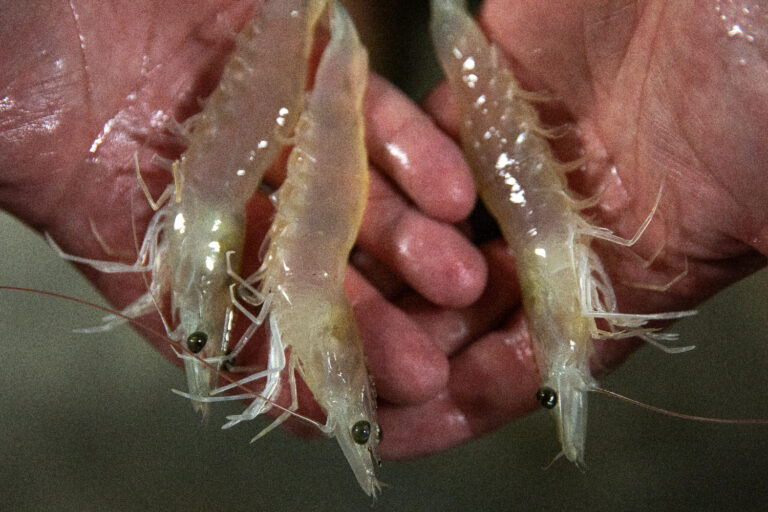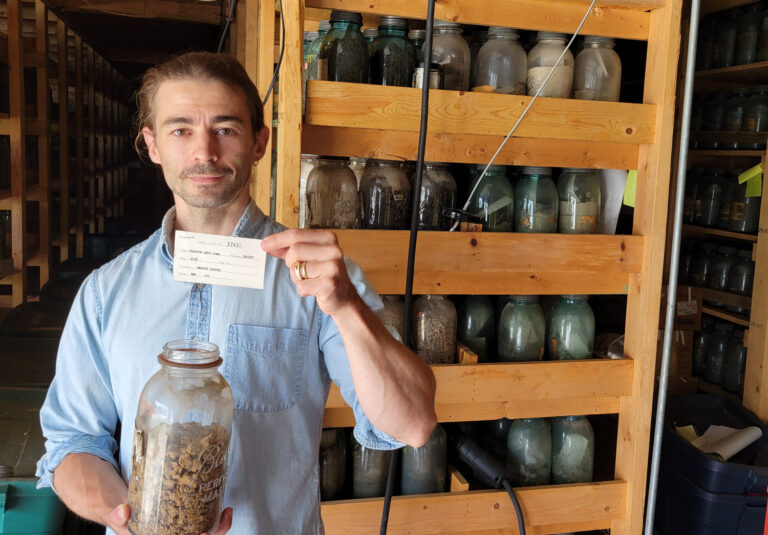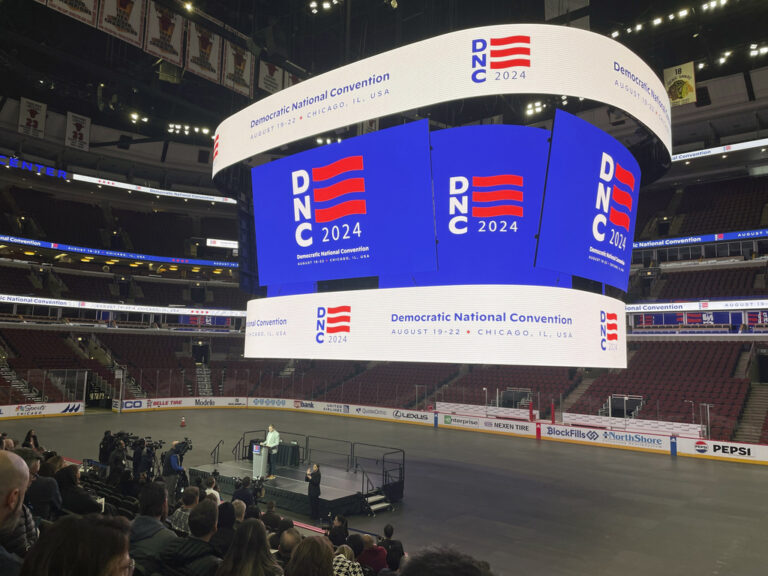A group of Midwestern shrimp farmers are on a mission to provide Americans with better-tasting, sustainable shrimp. The industry struggled during the COVID-19 pandemic, but farmers remain hopeful that indoor shrimp farming will come back stronger than ever.
Triple J Farms in Foristell, Missouri, looks like a typical Midwestern farm — a red barn sits at the end of a gravel road surrounded by cornfields. But the crop produced here is shrimp.
Co-owner Jeff Howell said the idea to become shrimp farmers began when the topic came up at a family gathering.
“My dad was reading an article in the ‘Soybean Digest’ about how they were trying to make shrimp feed out of soybeans. And that just sparked an interest (in) raising shrimp in the Midwest,” Howell said.
Together with his two brothers, Howell transformed a dirt-floored barn into an aquaculture facility in eight months. Eight years later, it pumps out 5,000 pounds of Pacific Whiteleg shrimp each year.
“We can do something somebody says you can’t,” Howell said. “We can raise shrimp in this big red barn out in the middle of a cornfield in Foristell, Missouri.”
Howell isn’t the only landlocked shrimp farmer, though. Over the past 15 years, a couple dozen indoor shrimp facilities have opened in Illinois, Iowa, Nebraska, Minnesota and other Midwestern states.
Experts say aquaculture, a method used to produce aquatic organisms in controlled conditions, can be a new market for farmers.
Though commercial shrimp farms first came to the United States in the 1960s, about 90% of the shrimp Americans eat is still imported, said Amy Shambach, aquaculture marketing outreach associate for the Illinois-Indiana Sea Grant.
As consumers start to prioritize sustainability and freshness when shopping for seafood, Shambach said inland shrimp farming can fill the need.
“To be able to raise a high valued seafood product in people’s backyard is just really an amazing opportunity for farmers,” she said.
But Shambach explained the industry has a long way to go. Shrimp from the Midwest makes up less than 1% of the U.S. market. Many farms closed because of the COVID-19 pandemic and natural disasters on the coasts that disrupted Midwest farmers’ ability to purchase shrimp larvae.
“That’s made it really hard for new farms that are interested in starting up in the aftermath of COVID to have the confidence that they’ll be able to have all the supplies and resources they need to run a successful business,” Shambach said.
But Shambach said challenges are to be expected in a new industry.
“We’re still in (the) infancy of indoor shrimp farming,” she said. “There are a lot of growth potentials.”
Growing seafood on land
The science that allows Howell and other farmers to produce shrimp far from the ocean is fairly simple.
“We’re basically self-enclosed inside this barn right here,” Howell said.
A few times a year, Howell orders 30,000 10-day-old shrimp from a hatchery in Florida, which he keeps in nursery tanks for about a month. After they’ve grown from the size of an eyelash to about an inch long, Howell transfers the shrimp to 14 temperature-controlled production tanks, where they stay until harvest about three months later.
Throughout the process, Howell supplies the tanks with shrimp feed, simple syrup, probiotics and baking soda. Heterotrophic bacteria living in the tanks eat the shrimp waste and keep the water clean, allowing Howell to constantly reuse the same water he started with eight years ago.
Howell and his brother James keep a constant tab on the water, testing for changes in salinity, pH, nitrates and carbon dioxide, among other things.
Not only is his method sustainable because it produces no waste, but it also creates a better tasting shrimp, Howell said.
“Everything that we can get from our grocery stores or Walmart – it’s frozen and thawed, frozen and thawed. These are fresh,” he said, “just pure shrimp.”
Jackson Kimle, the president and founder of Midland Co. in Ames, Iowa, uses a slightly different strategy than Howell. Instead of heterotrophic bacteria and shrimp feed, Midland Co. uses algae, which keeps the tanks clean and acts as a food source for the species.
Kimle said he thinks investing in America’s favorite seafood is a smart decision.
“That’s our highest import seafood of all species is shrimp. My play is that it’s worth putting in the work to make fresh, high quality shrimp available,” he said.
Though growing shrimp on land is not easy, Kimle stores his faith in knowing his shrimp taste better than the frozen ones Midwesterners are accustomed to.
“If you want to sell a premium price product, you need to match it with quality. And that’s really what we’ve seen. Our shrimp and other fresh shrimp really can ruin the frozen imports for you,” he said.
Expanding ‘seafood’ in the Midwest
It’s hard to know exactly how many indoor shrimp farms are scattered across the Midwest and Great Plains, but Shambach said she expects the industry to grow.
“As the shrimp farmers get more years under their belt, people see that,” she said, “and they’re an example and an inspiration for other farmers to start up.”
Karlanea Brown and her husband, Darryl, are working to help other farmers get started. They opened RDM Shrimp in Fowler, Indiana, in 2010, one of the only inland shrimp operations in the country at the time.
Brown said they want to help other farmers, because they had no one to turn to with questions when they got started.
“I’ve already been through the worst of it all. I can tell you any way to kill a shrimp. I know exactly how to do that,” she laughed. “But I also know how to keep them alive.”
Brown and her husband provide consulting services to new farms, including Triple J. So far, they have helped establish 22 shrimp farms in the country and 14 internationally. To anyone interested in starting a Midwestern shrimp farm, Brown said she warns them of the challenge.
“It’s not an easy or get-rich-quick scheme by any means,” she said. “I’m dealing with Mother Nature, and Mother Nature does her own thing.”
In Missouri, Howell is also looking to consult for new shrimp farms. Growing shrimp instead of importing it supports sustainable oceans, he said.
“If you can get more people to do it in a sustainable manner, you could stop overfishing in the oceans,” he said. “You could let (it) start rebuilding and healing.”
This story was produced in partnership with Harvest Public Media, a collaboration of public media newsrooms in the Midwest. It reports on food systems, agriculture and rural issues.
9(MDM5MjE5NTg1MDE1Mjk1MTM5NjlkMzI1ZQ000))







